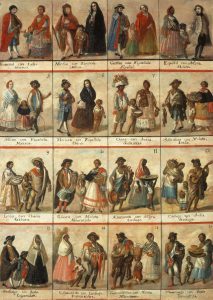This week we have looked at various casta paintings and how they reflect the ‘colonial experience’. At a first glance, through the lecture video and just by viewing the casta painting I have attached, it is easy to see that the colonial experience was NOT easy to navigate and had many more levels of social complexity that I think the Spanish colonial conquistadors and later colonial elites would have preferred. Even the term ‘colonial experience’ alludes to one experience, and not the reality of the various experiences that took place.
There were a lot of aspects that had to be explored and constructed in order to maintain the Spanish at the top of the newly emerging colonial social hierarchy in the Americas. Through this week’s reading on the casta paintings on top of what I have already discussed, there is a very clear comparison between the individuals depicted in the paintings and those people that were photographed for eugenic research purposes in the 19th and 20th centuries.
I believe that the reason these casta paintings were so prevalent and are still discussed today (our class is an example of that) is due to the authority that surrounded them. As the reading mentioned, the paintings were displayed in prestigious institutions as well as offices and places of work. Additionally, bearing large similarities to the eugenics, the paintings were illustrated as sort of a ‘sure thing’ with little possibility for questioning, at least within the paintings themselves. In the painting I have attached, the ‘product’ of the mixing of races is much like a mathematical equation. A plus B clearly equals C and will not equal D or E, only C.
Of course, we know that the realities of the colonial life were not so clear-cut and by creating a chart like these ones, all realities outside the specific chart are ignored. In the case of eugenics, when an individual did not meet their racial measurements, they were simply said to be ‘abnormal’. Thus, when discussing Latin American identity, if a person that is supposed to be depicted in the chart does not identify with their depiction, that may have caused for a very problematic sense of identity, much like Professor Beasley- Murray mentioned in his lecture.
The social hierarchy that is created through these paintings is clear as you look towards the bottom of the grid, in which the individuals are physically darker, have complicated names, and are wearing no shoes.
However, because the reading suggests that the casta paintings may not have been expensive at their time, would a Tente en el Aire or a No te Entiendo family have displayed these in their homes? If not, how effective was the painting’s not-so-subliminal message? Do people today who may experience a complicated relationship with identity and culture reflect on these paintings a possible root of the problem or are they viewed as historical obsolete pieces?


I like your point about how, by trying to create a neat grid of ethnic possibilities for the people living in Latin America at the time, the Spanish elites might have created more confusion within those people as to what they identify themselves as. That might still have an effect today, as we still try to define what a “Latin American” person is even though all the ethnic groups that live in it and have been a part of its history are not easily distinguishable.
I enjoyed your comparison between the paintings and mathematical equations because you’re right they left little to no room for contestation. I was also wondering how much the paintings effected society and the people’s identity. As in, did the racial/ “social” hierarchy that already existed become more rigid after the paintings/because of the paintings and did they change people’s views of themselves? Really interesting read!